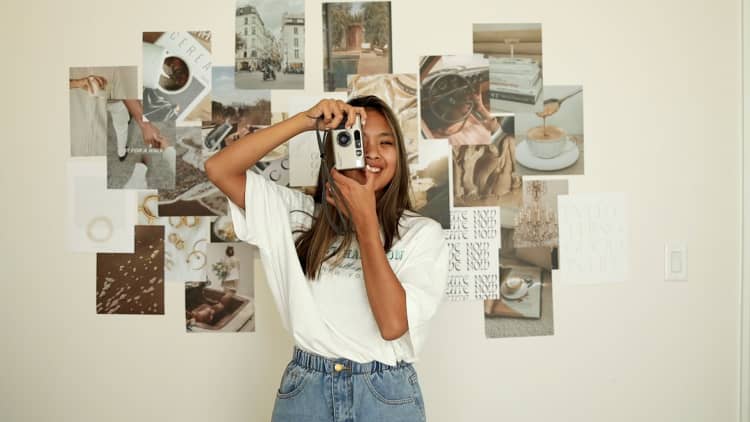Sean Audet stumbled into photography as a career by accident, and nearly for free.
It was 2016, and the trained fine-dining chef was running a pop-up restaurant two nights per week and working in culinary research at Red River College in Winnipeg, Canada. While developing new recipes for the college’s clients, small- and medium-sized restaurants, he had an idea: He and his students could stage and photograph food to help those clients advertise their businesses.
Audet quickly realized he had a knack for the work and started taking on his own clients for a food photography side hustle two years later. He used the school’s cameras, lights and backdrops to cut costs.
By 2020, he garnered enough business to invest roughly $20,000 in CAD, or about $15,200 U.S., in new equipment. He quit his jobs and become a full-time photographer.
Last year, Audet brought in roughly $133,900 U.S., according to documents reviewed by CNBC Make It — more than he ever earned in higher education or as a sous chef, he says. A majority of that business came from clients on freelance platform Fiverr, he adds.
Leaving a steady 9-to-5 job to become a freelancer was risky, but Audet says he had to give it a try.
“Every once in a while, I’ll stumble upon something that gets me super excited,” Audet, 30, tells CNBC Make It. “With no prompting, I’ll just start working an extra 12 to 14 hours a day on something that interests me. When that happens, I feel like you have to pay attention.”
Here’s how Audet scaled his side hustle into a full-time job, and how he plans to use his interest in A.I. to make more money.
Prioritizing passion over fear, and doubling his income
Audet studied biochemistry at The University of Winnipeg. His post-graduation plan was medical school, until he took a job at a nearby restaurant during college and fell in love with the kitchen.
So, after graduating in 2013, Audet went to culinary school instead. He became a sous chef and started the pop-up restaurant, which had a seven-course tasting menu, with a friend in Winnipeg.
His friend-turned-business partner also had a connection at Red River College, and suggested Audet fill in teaching “Pastry Arts” in 2016. Juggling both the teaching job and the pop-up, he was earning roughly $56,500 U.S. per year, he says.
Audet at Red River College, where he learned he had a knack for food photography, in 2017.
Sean Audet
He loved teaching and got involved in the school’s research department, where he first learned to “marry cooking and photography.”
“Spending almost a decade in fine dining, plating beautiful food, helped me segue into this niche,” he says. “It really gave me a leg up, and I started booking bigger clients almost immediately.”
Those bigger clients didn’t result in a bigger paycheck, or at least not at first. Audet estimates he only brought in $19,000 U.S. in his first year, not nearly enough to leave his full-time job.
In 2019, he raised his prices and his reputation got him more work, largely from returning customers who offered him regular projects. As a result, his income doubled.
Pursuing photography while still co-running the pop-up and working at the college was taxing, and cost Audet virtually all of his free time, he says. He regularly worked 12-hour days seven days a week, juggling three roles and pushing himself to pick up new photography skills along the way.
In 2020, he left his pop-up business and research position at the college. At the time, he was bringing in roughly $76,000 U.S. through photography.
As his business has grown, so have the costs. Now, Audet estimates he spends up to $23,000 U.S. to hire lighting specialists, models, makeup artists and other contract workers for photoshoots. But, even with those expenses, Audet is still bringing in six-figures, and nearly double what he made working two jobs.
Automation ‘is the key to reducing your workload’
Audet doesn’t have plans to change careers again, though he is already learning new skills to keep his interest piqued. He uses artificial intelligence tools like ChatGPT to craft emails to clients and build individual business plans.
“Automation, I think, is the key to reducing your workload,” Audet says. “When a client first reaches out to me, I need to be able to quickly deliver a bunch of information about services and costs, but I need to be able to do that in a nice, succinct and personalized way. I think that’s how you get and keep really great clients.”
He can’t yet rely on these tools to do higher-level work, Audet says. He’s tried out editing images in other AI programs, like Midjourney, but the tech isn’t to the point where he feels comfortable using it on professional projects.
“If the technology can do like 90% of the job, that’s not good enough when you’re working with clients paying a lot of money,” he says. “So the impact of it on my business is still relatively low.”
Conversions from CAD to USD were done using the OANDA conversion rate of 1 CAD to 0.75422 USD on July 14, 2023. All amounts are rounded up to the nearest dollar.
DON’T MISS: Want to be smarter and more successful with your money, work & life? Sign up for our new newsletter!
Get CNBC’s free Warren Buffett Guide to Investing, which distills the billionaire’s No. 1 best piece of advice for regular investors, do’s and don’ts, and three key investing principles into a clear and simple guidebook.

